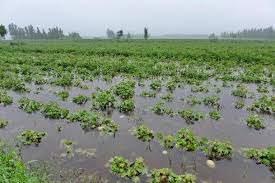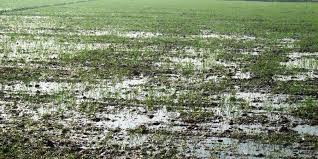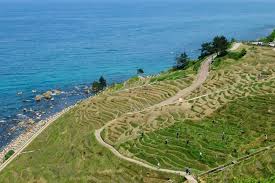Sea level rise is an increasingly pressing issue that poses significant threats to coastal regions worldwide, especially in agricultural areas. As global temperatures rise due to climate change, polar ice melts, and oceans expand, coastal areas face the risk of flooding and erosion. This process is particularly concerning for agricultural land along coastlines, which is critical for food production and local economies.
Farmers in these areas rely on fertile soil and stable ecosystems to grow crops and raise livestock, but rising sea levels can disrupt these foundations and reduce land productivity.
The impact of sea level rise on coastal agricultural land includes soil salinization, erosion, and increased flooding. Saltwater intrusion into freshwater sources and soil is one of the primary issues, as salt can damage crops and make the land unsuitable for future cultivation. Moreover, soil erosion caused by more frequent and intense storm surges depletes fertile topsoil, reducing the land’s agricultural potential.
Flooding exacerbates these issues, leading to crop damage, loss of livestock, and the destruction of infrastructure essential for farming operations.
These effects are not only environmental but also economic. Coastal agricultural communities face the risk of reduced yields, leading to income loss and increased vulnerability. Many farmers may be forced to relocate or switch to less vulnerable crops, which can be costly and may not fully compensate for the losses.
As sea levels continue to rise, these challenges are expected to grow, placing additional strain on food security and agricultural sustainability. Addressing these issues requires a combination of adaptation strategies, improved farming practices, and global efforts to mitigate climate change and protect coastal agricultural lands from the encroaching sea.
Causes of Sea Level Rise
Sea level rise is primarily caused by several interconnected factors:
1. Thermal Expansion: As the Earth’s atmosphere and oceans warm due to increased greenhouse gas emissions, seawater expands thermally. This expansion contributes to rising sea levels globally.
2. Melting of Land-Based Ice: The melting of glaciers, ice caps, and polar ice sheets adds freshwater to the oceans, further contributing to sea level rise. This process has accelerated in recent decades due to global warming.
3. Loss of Ice Mass from Greenland and Antarctica: The accelerated melting of Greenland and Antarctic ice sheets, driven by warmer ocean temperatures and atmospheric conditions, is a major contributor to rising sea levels.
4. Changes in Ocean Currents and Circulation: Alterations in ocean currents and circulation patterns can redistribute heat and water around the globe, influencing regional sea level changes.
5. Land Subsidence: In some coastal areas, land subsidence—caused by natural processes or human activities such as groundwater extraction and sediment compaction—can exacerbate the effects of sea level rise.
6. Tectonic Movements: Geological processes, including tectonic movements and rebound from past ice ages, can locally affect sea level relative to the land.
Changes in Soil Salinity
1. Intrusion of Saltwater: Rising sea levels can lead to saltwater intrusion into coastal aquifers and agricultural lands. This intrusion increases soil salinity, making it less suitable for many crops that are sensitive to salt. High soil salinity reduces crop productivity and can render agricultural land unusable without costly mitigation measures.
2. Impact on Freshwater Sources: Coastal agriculture relies on freshwater sources such as rivers and groundwater. As sea levels rise, saltwater intrusion can contaminate these freshwater supplies, further limiting irrigation options and reducing water availability for agriculture.
Flooding and Waterlogging of Agricultural Lands

1. Increased Flooding Events: Higher sea levels increase the frequency and severity of coastal flooding events. Floodwaters inundate agricultural fields, causing crop damage, soil erosion, and loss of productivity. This can lead to financial losses for farmers and threaten food security in affected regions.
2. Waterlogging: Sea level rise can lead to waterlogging of agricultural lands, especially during high tides and storm surges. Excess water saturation reduces soil oxygen levels, hindering root growth and nutrient uptake by crops. Waterlogged conditions also promote the growth of anaerobic bacteria, which can further degrade soil quality.
Impact on Crop Yields and Livestock
1. Reduced Crop Yields: Coastal crops may experience reduced yields due to increased soil salinity, waterlogging, and changes in growing conditions caused by sea level rise. Crops sensitive to salt, such as rice and many fruits and vegetables, are particularly vulnerable.
2. Livestock Challenges: Coastal livestock face risks from reduced grazing areas, increased exposure to flooding, and potential saltwater intrusion into freshwater sources. Ensuring adequate feed availability and managing animal health becomes more challenging in affected regions.
Adaptation Strategies for Coastal Farmers
Coastal farmers can adopt several adaptation strategies to mitigate the impacts of sea level rise on agriculture:
1. Crop Diversification: Planting a variety of salt-tolerant crops and selecting crop varieties resilient to changing environmental conditions can help maintain agricultural productivity in saline-prone areas.
2. Improved Water Management: Implementing efficient irrigation systems, rainwater harvesting, and water-saving techniques helps conserve freshwater resources and mitigate the impacts of saltwater intrusion.
3. Elevated Farming Platforms: Constructing raised beds or platforms for crops and livestock can protect against flooding and waterlogging, preserving soil structure and maintaining productivity during inundation events.
4. Shoreline Protection: Building coastal defenses such as seawalls, dikes, and mangrove restoration can protect agricultural lands from erosion and storm surges, safeguarding crops and infrastructure.
5. Integrated Farming Systems: Integrating crops with aquaculture or livestock systems can diversify income sources and enhance resource use efficiency, promoting sustainable agriculture in coastal areas.
Case Studies of Affected Regions
1. Bangladesh: Low-lying coastal regions in Bangladesh face severe challenges from sea level rise, including increased salinity in rice paddies and loss of freshwater resources essential for agriculture.
2. Netherlands: The Netherlands has implemented extensive coastal management strategies, including dikes and polders, to protect agricultural lands and urban areas from rising sea levels and storm surges.
3. Louisiana, USA: Coastal areas of Louisiana experience land loss and saltwater intrusion, impacting agriculture and fisheries. Restoration projects aim to mitigate these effects through wetland restoration and sustainable land use practices.
Read Also Principles and Techniques in Livestock Breeding (Methods of Genetic Improvement)
Policy Recommendations for Sustainable Agriculture

1. Coastal Zone Management: Implementing integrated coastal zone management plans that prioritize sustainable land use practices, habitat conservation, and disaster risk reduction measures.
2. Research and Development: Investing in research and development to develop climate-resilient crop varieties, innovative water management technologies, and sustainable farming practices suitable for coastal environments.
3. Financial Support: Providing financial incentives and support mechanisms for coastal farmers to adopt climate-smart agriculture practices, such as subsidies for resilient crop seeds and infrastructure improvements.
4. International Collaboration: Collaborating internationally to share knowledge, technology, and resources for addressing global climate challenges and supporting vulnerable coastal communities.
5. Education and Capacity Building: Promoting awareness and providing training programs for coastal farmers on climate change impacts, adaptation strategies, and sustainable agricultural practices.
Community Engagement in Adaptation Efforts
Community engagement plays a crucial role in enhancing resilience and promoting sustainable practices in coastal agriculture:
1. Knowledge Sharing and Awareness: Educating local communities about the impacts of sea level rise on agriculture and the importance of adopting climate-smart practices fosters understanding and commitment to adaptation efforts.
2. Participatory Decision-Making: Involving farmers, local leaders, and stakeholders in decision-making processes for adaptation strategies ensures that solutions are context-specific, culturally appropriate, and effectively implemented.
3. Capacity Building: Building the capacity of coastal communities through training programs, workshops, and demonstration farms equips farmers with the skills and knowledge needed to implement adaptive measures and respond to climate challenges.
4. Community-Based Monitoring: Engaging communities in monitoring environmental changes and agricultural impacts enables early detection of risks, facilitates timely responses, and promotes adaptive management practices.
Role of Technology in Mitigating Impacts
Technological innovations offer promising solutions to mitigate the impacts of sea level rise on coastal agriculture:
1. Precision Agriculture: Utilizing remote sensing, GIS (Geographic Information Systems), and drones enables farmers to monitor soil conditions, water availability, and crop health, optimizing resource use and enhancing productivity in variable coastal environments.
2. Climate-Resilient Crop Varieties: Breeding programs and genetic engineering techniques develop crop varieties resilient to saltwater intrusion, flooding, and heat stress, ensuring stable yields and food security in vulnerable coastal regions.
3. Smart Irrigation Systems: Automated irrigation systems, soil moisture sensors, and weather forecasting tools improve water efficiency, minimize water wastage, and support sustainable water management practices in water-stressed coastal areas.
4. Aquaculture Integration: Integrating aquaculture with coastal farming systems diversifies income sources, enhances nutrient cycling, and promotes ecosystem resilience, creating synergies between agriculture and marine resource management.
Read Also Digestive Anatomy of Ruminants
Economic Implications for Coastal Farming

1. Loss of Agricultural Land: Coastal erosion, saltwater intrusion, and flooding can lead to the loss of productive agricultural land, reducing farm income and displacing communities dependent on agriculture for livelihoods.
2. Increased Production Costs: Rising sea levels may necessitate investments in costly infrastructure such as seawalls, drainage systems, and elevated platforms to protect farms from inundation, adding to production expenses for coastal farmers.
3. Market Access and Trade: Disruptions in agricultural production and land use changes due to sea level rise can affect market access, trade relationships, and food supply chains, impacting local economies and regional food security.
4. Tourism and Coastal Development: Coastal agriculture often overlaps with tourism and urban development, creating competition for land and resources. Sea level rise-related impacts on agriculture may also affect tourism revenues and local economies dependent on coastal attractions.
The Future of Coastal Agriculture in a Changing Climate
The future of coastal agriculture hinges on adaptive strategies, resilience-building efforts, and sustainable development practices:
1. Adaptation and Resilience: Implementing adaptive strategies such as resilient crop varieties, improved water management, and ecosystem-based approaches ensures that coastal agriculture can withstand climate impacts and sustain productivity over the long term.
2. Policy Support and Investment: Governments, international organizations, and stakeholders must prioritize policy support, funding initiatives, and investment in climate-smart agriculture to empower coastal communities and safeguard agricultural livelihoods.
3. Innovation and Research: Continued innovation in technology, research, and development is essential for developing new climate-resilient agricultural practices, enhancing adaptive capacity, and fostering sustainable coastal food systems.
4. Collaboration and Knowledge Sharing: Collaborative efforts among governments, research institutions, NGOs, and local communities foster knowledge sharing, innovation diffusion, and best practices adoption, enhancing resilience across global coastal agricultural landscapes.
Do you have any questions, suggestions, or contributions? If so, please feel free to use the comment box below to share your thoughts. We also encourage you to kindly share this information with others who might benefit from it. Since we can’t reach everyone at once, we truly appreciate your help in spreading the word. Thank you so much for your support and for sharing!
Read Also How to Make Your Own Organic Pesticides

